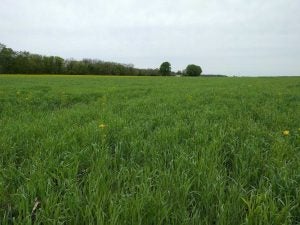We often hear that, “cover cropping isn’t a destination, it’s a journey.” Even the best “cover crop journeymen” make mistakes. To make sure you don’t throw the brakes on your soil health journey with cover crops, here’s four key items to jog your memory for this fall.
Timing is everything. Watch your planting date charts for all the species in your mixes. This will help ensure you’re not planting your cover crops so early that they will mature and go to seed. It can also help set realistic expectations on the growth of your cover crops. Don’t plant radishes in October and expect it to be the size of a toddler. It’s not going to happen. Also be aware of that most seed will rot over winter. Other plants that do grow in the spring can be terminated with an herbicide program.
Timing is still everything. If your soil is dry because it has not rained in a month, and your 10-day forecast has zero chances of rain in it, probably steer away from aerial applying cover crops.
- Please reread: I did not say to not fly cover crops. Thousands of farmers every year fly cover crops into standing cash crops and have great stands going into winter! I love aerial application because we jump over the hurdle of “I can’t plant cover crops because I harvest too late.” I just want to emphasize how much rain in your forecast is critical to see a good stand of your cover crops in the fall.

Did I mention timing is everything? Go back to your fields’ histories and double check your herbicide residuals. Residuals can linger in the soils from weeks to months depending on the chemistry. If plant-back time exceeds when you can plant a cover crop, don’t order the seed. It is hard to get a cover crop established in this situation. Are you not sure when or what rate you sprayed? You can conduct a bioassay test to get an official analysis of any residual herbicide(s) in the soil that would delay the development of your cover crops. See this article from University of Nebraska.
Order and ship your seed … yesterday. You know you are going to plant cover crops. You will either aerial/surface apply, use a drill or traditional seeder, interseed, slurry manure seed, or use a seed box mounted somewhere on your combine to get the seed to the ground. So why not order your cover crop seed and get it in the barn now?! Your brassicas, broadleaves, and clovers are in good supply throughout the industry. It’s no secret that two of the most commonly used cover crops will be in short supply this year; oats and rye (queue @CoverCropGal’s anxiety). Canada is in a severe drought where rye is grown. American farmers have switched from growing rye to a crop that is more profitable. Order your seed and ship it now. It might not be available once you are finished harvesting.
From what species can be planted when, to weather and herbicide residuals, and even to ordering your cover crop seed, timing really is everything to make the most of your cover crop planting.
Jenna Langley Blue is a regional sales manager for La Crosse Seed in Indiana. You can follow her on Facebook, Twitter, and Instagram.



